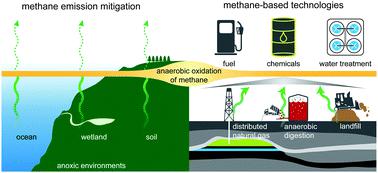当前位置:
X-MOL 学术
›
Energy Environ. Sci.
›
论文详情
Our official English website, www.x-mol.net, welcomes your
feedback! (Note: you will need to create a separate account there.)
Roles and opportunities for microbial anaerobic oxidation of methane in natural and engineered systems
Energy & Environmental Science ( IF 32.4 ) Pub Date : 2021-07-27 , DOI: 10.1039/d1ee00708d Chen Cai 1, 2, 3, 4, 5 , Xueqin Zhang 1, 2, 3, 4 , Mengxiong Wu 1, 2, 3, 4 , Tao Liu 1, 2, 3, 4 , Chun-Yu Lai 1, 2, 3, 4 , Joshua Frank 1, 2, 3, 4 , Bingqing He 1, 2, 3, 4, 6 , Esteban Marcellin 2, 3, 4, 6 , Jianhua Guo 1, 2, 3, 4 , Shihu Hu 1, 2, 3, 4 , Zhiguo Yuan 1, 2, 3, 4
Energy & Environmental Science ( IF 32.4 ) Pub Date : 2021-07-27 , DOI: 10.1039/d1ee00708d Chen Cai 1, 2, 3, 4, 5 , Xueqin Zhang 1, 2, 3, 4 , Mengxiong Wu 1, 2, 3, 4 , Tao Liu 1, 2, 3, 4 , Chun-Yu Lai 1, 2, 3, 4 , Joshua Frank 1, 2, 3, 4 , Bingqing He 1, 2, 3, 4, 6 , Esteban Marcellin 2, 3, 4, 6 , Jianhua Guo 1, 2, 3, 4 , Shihu Hu 1, 2, 3, 4 , Zhiguo Yuan 1, 2, 3, 4
Affiliation

|
Reduction in methane emissions to the Earth's atmosphere is a critical strategy for tackling climate change. It is well established that anaerobic oxidation of methane (AOM) associated with sulfate reduction functions as an important methane sink in marine sediments. However, recent findings show that AOM uses diverse electron acceptors across a range of habitats, prompting examination of the potential role of AOM in mitigation of methane emissions and global climate change in non-marine environments. Methane is also a valuable energy source, widely used for production of electricity. Recent studies suggest that AOM could be used to produce liquid fuels/chemicals. The potential involvement of CO2 in product formation is particularly exciting as methane bioconversion could act as a net sink of CO2. The discovery that AOM is able to transfer electrons to solid electron acceptors suggests that methane may be a suitable source of electrons for a bioelectrochemical, biosynthesis cell. In addition, AOM has been used for pollution control and environmental remediation, such as nitrogen removal from contaminated water. Herein, we review and discuss implications of the latest scientific discoveries in AOM for methane emissions from aquatic and terrestrial environments, and methane as a feedstock for various biotechnology platforms.
中文翻译:

甲烷微生物厌氧氧化在自然和工程系统中的作用和机会
减少地球大气中的甲烷排放是应对气候变化的关键战略。众所周知,与硫酸盐还原相关的甲烷厌氧氧化 (AOM) 是海洋沉积物中重要的甲烷汇。然而,最近的研究结果表明,AOM 在一系列栖息地中使用不同的电子受体,促使人们研究 AOM 在缓解非海洋环境中的甲烷排放和全球气候变化方面的潜在作用。甲烷也是一种宝贵的能源,广泛用于发电。最近的研究表明,AOM 可用于生产液体燃料/化学品。CO 2在产品形成中的潜在参与尤其令人兴奋,因为甲烷生物转化可以作为 CO 2的净汇. AOM 能够将电子转移到固体电子受体的发现表明,甲烷可能是生物电化学、生物合成细胞的合适电子来源。此外,AOM 已用于污染控制和环境修复,例如从受污染的水中去除氮。在此,我们回顾和讨论 AOM 的最新科学发现对水生和陆地环境中的甲烷排放以及甲烷作为各种生物技术平台的原料的影响。
更新日期:2021-08-12
中文翻译:

甲烷微生物厌氧氧化在自然和工程系统中的作用和机会
减少地球大气中的甲烷排放是应对气候变化的关键战略。众所周知,与硫酸盐还原相关的甲烷厌氧氧化 (AOM) 是海洋沉积物中重要的甲烷汇。然而,最近的研究结果表明,AOM 在一系列栖息地中使用不同的电子受体,促使人们研究 AOM 在缓解非海洋环境中的甲烷排放和全球气候变化方面的潜在作用。甲烷也是一种宝贵的能源,广泛用于发电。最近的研究表明,AOM 可用于生产液体燃料/化学品。CO 2在产品形成中的潜在参与尤其令人兴奋,因为甲烷生物转化可以作为 CO 2的净汇. AOM 能够将电子转移到固体电子受体的发现表明,甲烷可能是生物电化学、生物合成细胞的合适电子来源。此外,AOM 已用于污染控制和环境修复,例如从受污染的水中去除氮。在此,我们回顾和讨论 AOM 的最新科学发现对水生和陆地环境中的甲烷排放以及甲烷作为各种生物技术平台的原料的影响。











































 京公网安备 11010802027423号
京公网安备 11010802027423号